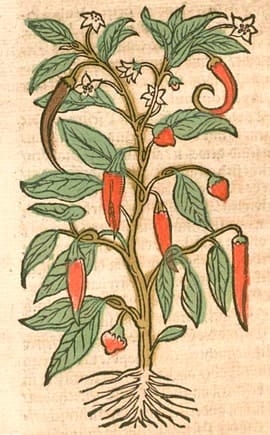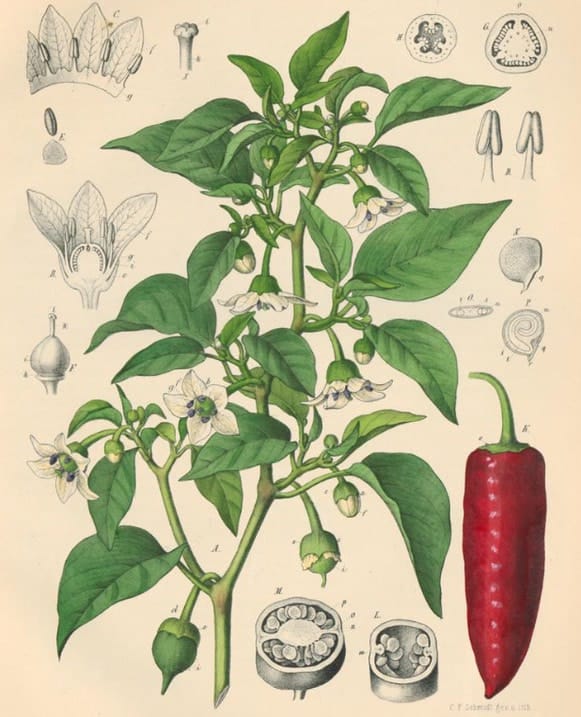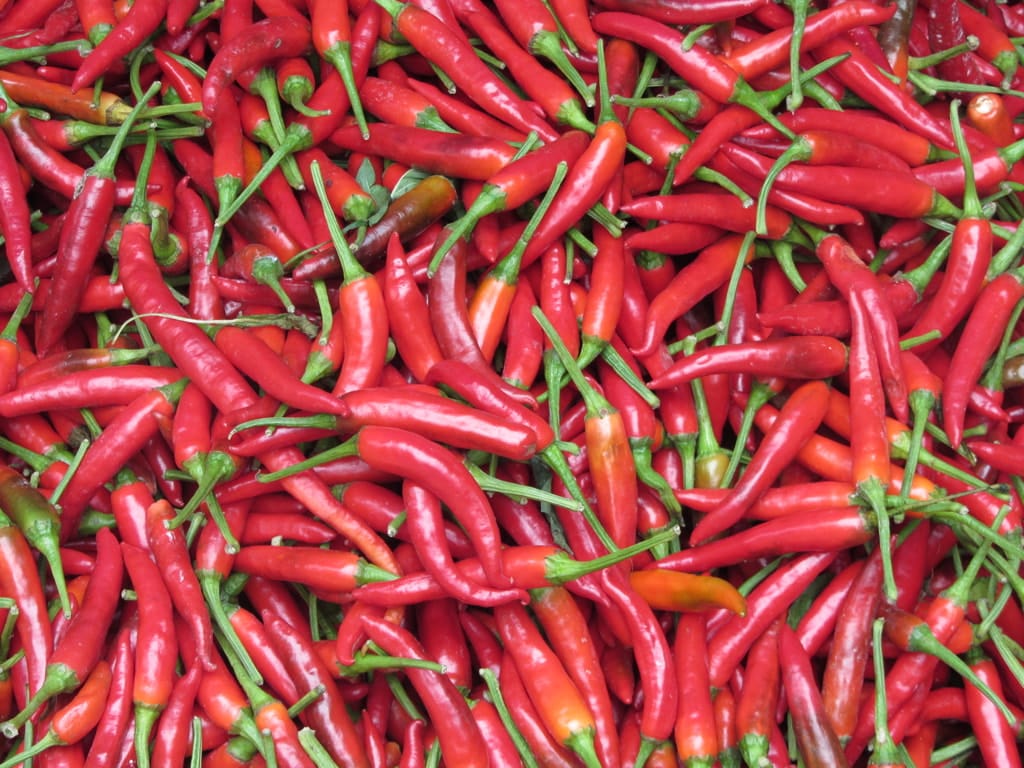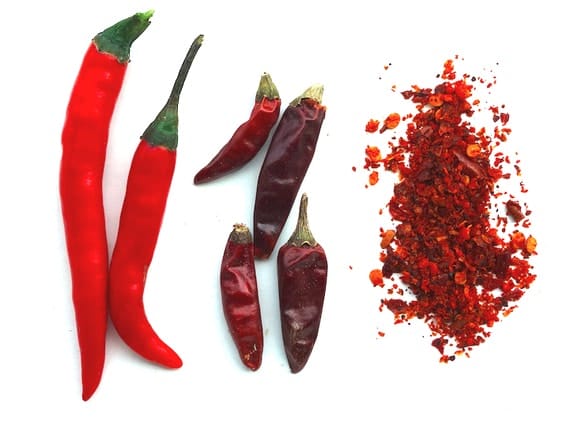Capsicum, Chili
Chili Pepper, Hot PepperFilfil-i-Surkh (Unani)
 Krauterbuch, Lonitzer, 1578
Krauterbuch, Lonitzer, 1578 C. annua
C. annuaAtlas der Officinellen Pflanzen, Berg & Schmidt, Leipzig, 1893

 Left: Fresh Chili; Center: Dried Chili; Right: Crushed Chili
Left: Fresh Chili; Center: Dried Chili; Right: Crushed Chili Members CLICK HERE for the PRO VERSION
Members CLICK HERE for the PRO VERSIONBotanical name:
Capsicum spp.
- C. annum var. annum (longum type)
- C. frutescens (syn. C. minimum)
- C. baccatum
- C. chinensis
- C. pubescens
Parts used:
Dried Fruit
Temperature & Taste:
Hot, dry. Pungent
Uses:
1. Warms the Yang, Clears Cold:
-coldness in the digestive system with flatulence, colic, poor digestion, loose stool
-coldness affecting the circulation or whole body, with cold hands and feet, chilblains, debility.
-internally and externally for lumbago, rheumatism, etc, associated with cold and Damp.
-marked debility with coldness and depression and with a feeble pulse.
-acute Wind-Cold Cold and Influenza
-all pain coming from Cold
2. Moves the Blood, Clears Stasis:
-pain associated with Trauma and Bruising
-a paste of the fresh fruit is given to patients following Trauma (India).
-the paste is given after birth as a Postnatal treatment, and for Chest Pain from blood stagnation. (India)
-Internally and externally for Sprains and Varicose Veins.
-poor circulation related to Heart weakness with Cold symptoms
-lowers Cholesterol level, reduces Hypertension.
3. Externally:
-all pain coming from cold; lumbago, arthritic and rheumatic pain
-pain from blood stagnation or bruising
-topically for Sprains
-Spider veins, Varicose veins
-mixed with honey as a paste and applied to the throat for acute sore throat or tonsillitis
-Capsicum ashes cleanse the teeth
-mix with turpentine and apply to knots, nodes or kernels on the body to dissolve them
Preparation:
… available in PRO version
Dose:
Powder: 50–500mg (typically 100–250mg);
Infusion or Decoction: 1–3 grams

Main Combinations:
1. Heart weakness with Poor circulation and Cold:
i. with Angina, Capsicum with … available in PRO version
ii. with Angina, Capsicum with … available in PRO version
iii. with marked Coldness, Capsicum with … available in PRO version
iv. with Depression, Capsicum with … available in PRO version
2. Cold Phlegm of the Lungs:
i. Capsicum with … available in PRO version
ii. Capsicum with … available in PRO version
3. Influenza with marked Cold, Capsicum with … available in PRO version
4. Chronic Sore Throat:
i. Capsicum with … available in PRO version
ii. Capsicum with … available in PRO version
5. Asthma, Bronchitis from Cold Phlegm:
i. Capsicum with … available in PRO version
ii. Capsicum with … available in PRO version
6. Constipation from Cold:
i. Capsicum with … available in PRO version
ii. Capsicum with … available in PRO version
7. Cold Pain, Rheumatism:
i. Capsicum with … available in PRO version
8. Topically for pain:
i. Capsicum with … available in PRO version
ii. ‘Indian Liniment‘: Tincture of Capsicum … available in PRO version
iii. Tincture of Capsicum, … available in PRO version
9. Arthritic pain, Capsicum with … available in PRO version
Major Formula:
Cautions:
1. Not used in Heat conditions or Yin deficiency
Main Preparations used:
-
Extra Info
- History
|
‘Clusius states that Capsicums were brought to India from Pernambuco by the Portuguese; from India they were introduced into Germany, and finally reached England in 1595. The Spaniards were acquainted with the spice as early as 1494. Chanca, physician to the fleet of Columbus in his second voyage to the West Indies, notices them among the productions of Hispaniola as a condiment used by the natives under the name of Agi, which is still the common name for them in Spanish. In English they were formerly known as Guinea-pepper, and the Portuguese call them Pimenta de Guine. Chili is the Mexican name. (Pharmacographia.) In the Indian vernaculars there is no special name for them, and they are not mentioned by any Sanskrit writers. Up to the present time the cultivation of the plant is carried on more extensively at Goa than at any other place in Western lndia, and capsicums are well known in Bombay as Govai-mirchi, “Goa pepper.” The Arabs call the chillie Filfil-ahmar, ” red pepper,” in Persian it is Filfil-i-surkh, which has the same meaning. Besides the two species commonly cultivated, several varieties of G. grossum are met with in India as ornamental plants in gardens; they are mostly remarkable for the size of their fruit; which is almost or entirely devoid of pungency; one variety, which has been named G. cerasiformis, has globular fruit resembling a cherry. A yellow capsicum, having a peculiar flavour, has been introduced into India from Nepal, and from it is prepared a very highly esteemed Cayenne |
pepper. In India C. minimum, though common in many parts of the country as a weed of cultivation, is seldom used by the natives, who call it Gachh-mirch, “tree pepper,” or Kafri-mirch,” negro’s pepper.” The Hindus and Indian Mahometans use capsicum very freely as a condiment, but the Arabs and Persians object to it. Medicinally the natives of India consider capsicum to be stomachic and stimulant, and a promoter of the regular action of the bowels: externally they use it as a rubefacient. The irritant properties are frequently taken advantage of to inflict torture upon prisoners and refractory children. In European medicine capsicum is used in the form of a plaster, or liniment, made with the ethereal tincture, in rheumatic and neuralgic affections; it produces warmth and redness of the part. Pads dipped in a strong infusion of the crushed pods may also be used; they should be covered with paraffin paper or oil silk, and may be kept on for several hours; as a gargle, or in the form of lozenges, it is used in tonsillitis, pharyngitis and relaxed sore-throat. In the West Indies it is used in infusion with cinnamon and sugar to relieve the sinking at the epigastrium felt by drunkards, and forms a most valuable diet drink for patient suffering from delirium tremens, as it satisfies the craving for stimulants. Large doses taken internally by persons who are not in the habit of using capsicum may produce gastro enteritis.’ (Pharmacographia Indica, Dymock, 1891) |
